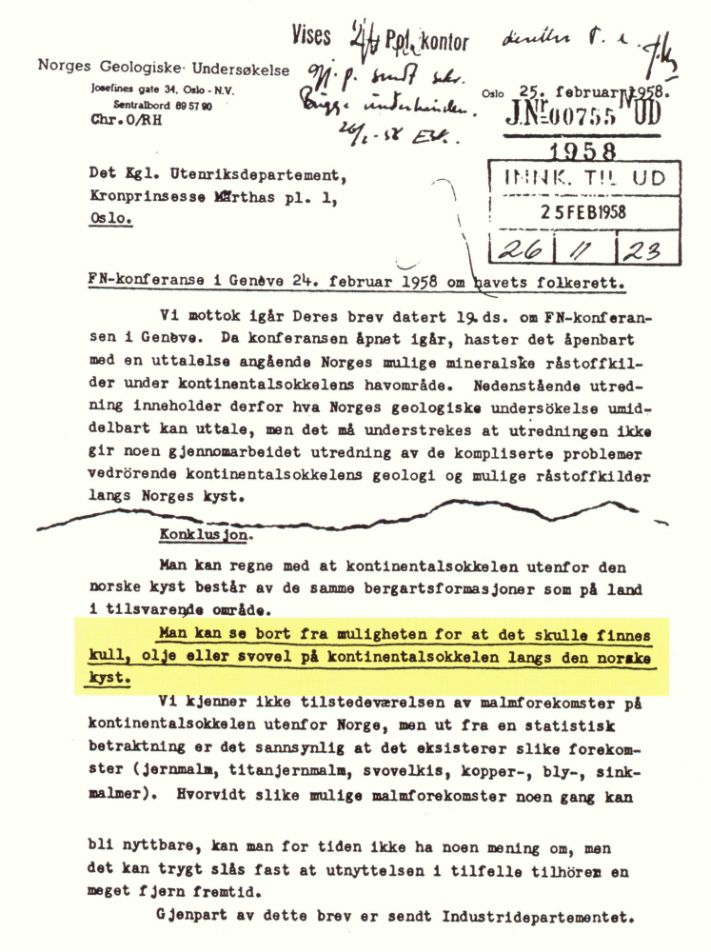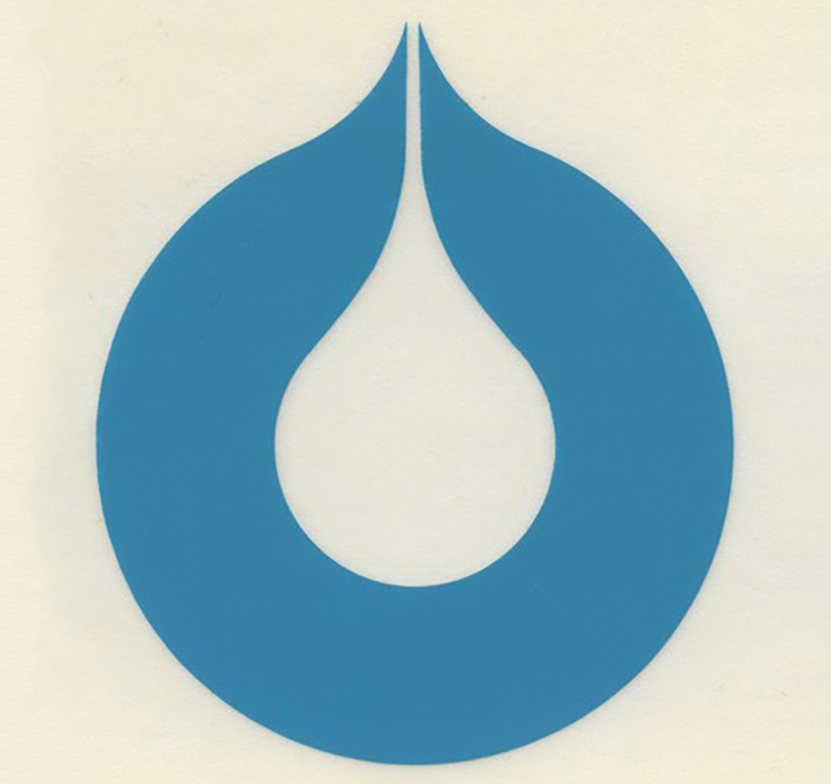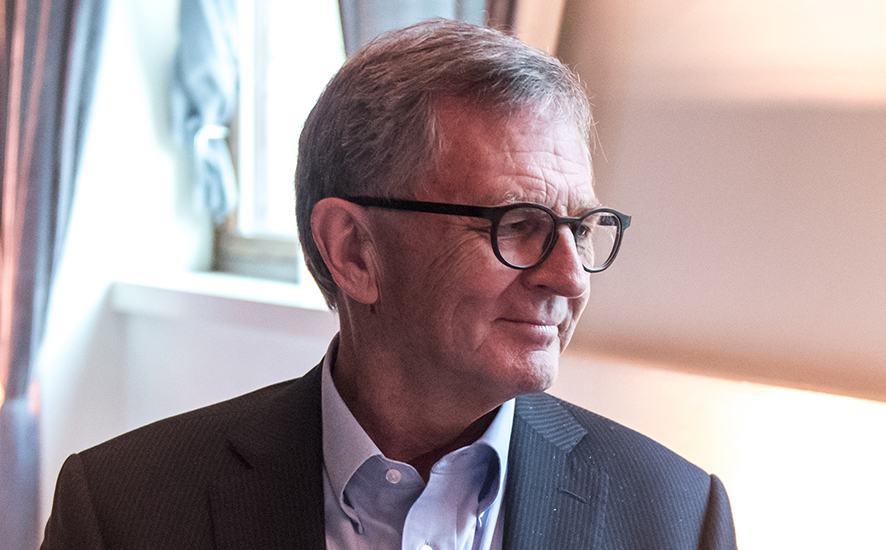Statoil as a red thread in Norway’s oil model

This company has served as red thread through Norway’s oil history and its“tripartite” oil model – comprising the policy-making government, regulators and a state-owned commercial company. But it has also been the subject of much controversy and major changes. Above all, this has been a history of adaptability and dynamism.
When Statoil celebrated its 40th anniversary in 2012,[REMOVE]Fotnote: Statoil was established by a decision of the Storting on 14 June1972. Its statutory general meeting took place on 18 September, which is regarded as the date of the company’s foundation. Jens Chr Hauge was elected as its first chair. Statoil had an initial capital of NOK 5 million, which was expanded a number of times in line with the company’s growth. When it secured a stock market listing in 2001, its share capital was just under NOK 5 billionand its stock market valuation was NOK 136 billion. petroleum and energy minister Ola Borten Moe declared that its history until then had been one of unique success. Few would dispute that assessment. The most surprising and important change in the company’s history to date was its partial privatisation and stock marketlisting in 2001. This underlines the strength and dynamism of the Norwegian oilmodel.
From doubt to conviction
It was foreign companies who had the idea of exploring for oil on the NCS, and they were the ones who found petroleum and began its production. The Norwegian government had already laid a solid foundation for national control of this new industry emerging off its shores, and quickly took the necessary steps to participate in operational activities.
Statoil became its most important instrument. It went without saying that the government would control the award of licences and levy taxes. But it was not so obvious that Norway would choose to establish a state-owned enterprise to participate directly in offshore operations. Had the centre-right coalition under Per Borten remained in office, the outcome could have been a state holding company. The change of government in 1971 was decisive for the model chosen.
 statoil som en rød tråd,
statoil som en rød tråd,The international oil companies unquestionably encountered a more conscious government in Norway than in many other countries. This also explains why the Norwegian oil model is viewed with respect worldwide and regarded as highly successful.
Norway’s oil adventure got off to a negative start in 1958, when the Norwegian Geological Survey (NGU) concluded that there was no prospect of finding hydrocarbons beneath the seabed along the country’s coast.
In 1962, however, Phillips Petroleum Company in Bartlesville, Oklahoma, (today ConocoPhillips) wrote to the government requesting a concession to explore for oil on the NCS. The authorities responded by adopting appropriate legislation and a tax system, and initiated negotiations with the UK and Denmark on dividing lines in the North Sea. The NCS was opened for exploration in 1965 with the country’s first offshore licensing round.
Oil in Norwegian
The Labour Party and prime minister Einar Gerhardsen were in charge of Norwegian oil policy until the NCS was opened. They lost the 1965 general election and were replaced by the Borten coalition.
Phillips discovered large commercial quantities of oil and gas in block 2/4 at the southern end of the NCS in 1969. This field was dubbed Ekofisk. That raised a major issue – what was this small country now to do?
The government appointed an organisation committee to study how the Norwegian state should participate in the petroleumindustry.[REMOVE]Fotnote: This committee was chaired by Knud-Endre Knudsen, who became the first chief executive of Saga Petroleum when this privately owned company was established a few months before Statoil in 1972. This body decided that the government should establish a holding company to participate in NCS licences without any operational activity. However, the Borten coalition collapsed in 1971, primarily as a result of internal tensions– particularly the question of EU membership.
Labour returned to office as a minority government under Trygve Bratteli. Finn Lied was industry minister, with Arve Johnsen as his state secretary (junior minister). They were both very much in favour of an operational oil company, and that was the outcome.
The result of the first referendum on Norwegian EU membership in 1972 resulted in the resignation of Bratteli’s government. That led in turn to the appointment of Johnsen as Statoil’s first chief executive. Lied later became the company’s chair for 10 important years of its growth.
The government opted for a tripartite model based on a division between three functions:
-
- the Ministry of Industry would have overall national responsibilityfor such issues as the award of licences
- the Norwegian Petroleum Directorate would be the regulatorresponsible for resource management and safety on the NCS
- Statoil (the Norwegian State Oil Company, to give it its full name)would be the state’s commercial instrument in the petroleum sector.
 statoil som en rød tråd,
statoil som en rød tråd,Established as a wholly state-owned limited company, Statoil had the industry minister (later the minister for petroleum and energy[REMOVE]Fotnote: The Ministry of Industry was responsible for oil matters until the Ministry of Petroleum and Energy was established in 1978.) as its general meeting.
Statoil was given the classic assignments and benefits of a state oil company, and became a mix of commercial enterprise and administrator. This prompted growing claims of preferential treatment from both politicians and the oil industry. But state ownership also imposed restrictions and disadvantages from the company’s own perspective. It became the instrument for stateparticipation on the NCS. First, the company was automatically given a 50 percent holding in all the licences – both promising and less attractive.
Second, it obtained the right to exercise the state’s options related to the sliding scale provision. This meant that Statoil’s holding in a licence could be increased if a particularly interesting discovery was made.
The company also benefited from the “carried interest” system, which meant that its exploration costs were met by its partners in a licence – including the other Norwegian companies.
Report no 25 to the Storting (1973-1974) on the petroleum industry’s place in Norwegian society represented in many ways a new stage in national oil policy. It specified, for instance, that revenues from oil production on the NCS should be used to create a qualitatively better society. The non-socialist parties perceived this as an ideological message which defined a specified direction for the government’s desired social development. Fears arose that oil revenues would be devoted to creating a socialist society.
Too big and too powerful?
The dispute over Statoil came to concentrate on its size, influence and exercise of power. It had come into being as a large and important social democratic project, and one hypothesis for its history is that the company was a true-born child of the Labour Party.
While the political opposition while mobilised against Statoil was rooted primarily in the Conservative Party, it also had adherents on the conservative wings of the Christian Democratic and Centre parties, and in the Liberal Party. The far-right Progress Party was strongly opposed to state involvement in the oil sector. It wanted to sell off the NCS wholesale and devote the proceeds to reducing taxes.
The Conservatives were the big winners in the1981 general election, and Kåre Willoch formed a minority government with parliamentary support from the Christian Democratic and Centre parties. One of the Conservative pledges in the election had been a partial privatisation of Statoil. But the time was not right for that. The government appointed a committee to assess a process known colloquially as “clipping Statoil’s wings”.
In 1984, the government succeeded in securing Storting support for a surprising reform which created the state’s direct financial interest (SDFI) in the petroleum industry. Part of Statoil’s holding in offshore licences was transferred to this new government instrument, which would ensure that a proportion of possible petroleum revenues went directly to the Treasury rather than via Statoil.
The government, and particularly Willoch and petroleum and energy minister Kåre Kristiansen, believed that Statoil had far more money than it needed to discharge its responsibilities on the NCS. Changes had occurred in the Norwegian oilmodel along the way. The sliding scale and carried interest systems had been dropped. Discussion came increasingly to concentrate on developing Statoil as a more commercial player without administrative functions. The SDFI reform was an important step in that direction, but it is by no means certain that all the politicians of the day appreciated the consequences.
Robust opposition to having Statoil’s “wings clipped” had been expressed by its board and management. They deployed a number of arguments, and maintained that the proposed change demonstrated a lack of confidence in the company. That would weaken its standing with partners and competitors, as well as reducing its ability to bear the cost of technological development and the execution of major projects.
Willoch has never accepted the term “clipping wings”. He says it was more a matter of “blunting the claws” of a company which had got hold of too much money, which had led in turn to wasteful spending.
Greater freedom
 Reorganiseringen av Statoil. Vingeklipping eller symbolpolitikk, forsidebilde, statoil som en rød tråd,
Reorganiseringen av Statoil. Vingeklipping eller symbolpolitikk, forsidebilde, statoil som en rød tråd,But the SDFI reform also had an upside for Statoil. The company acquired the freedom to expand internationally and developed ambitions beyond the NCS at an early stage. The SDFI system is not easy to understand at first glance. Why, one might ask, was it necessary to remove much of the cashflow from a company wholly owned by the state and also paying 78 per cent tax in order to secure better government control?
In a way, Statoil had grown beyond the governance of the politicians in terms of size, power and money. It could be worth remembering that, when the company was established, the politicians wanted its budget to be considered annually by the Storting. After a dispute between board and owner, a compromise was found in the “section 10” plan whereby Statoil was required to account to the Storting for its investment plans once a year.
The main consequence of the SDFI reform was a redistribution of state assets, from being increasingly at the disposal of a company before taxation to coming under direct control by the state as the owner of both the resources and the company.
Objectors to the SDFI claimed that the arrangement would create a new role for the state, with exposure to a turbulent market. The government had to buy the direct assets taken from Statoil and make direct investments in developing the field before the direct revenues could flow.
A year after the reform, oil prices slumped to USD 10 per barrel and the risk involved found immediate expression in negative accounting figures for the SDFI over several years. In the long-term perspective, however, this became a gilt-edged business for the government.
The SDFI had no operational role. Under the reform, Statoil would sell the state’s oil and gas under a special sales and marketing instruction. Nevertheless, it turned out along the way that the interests of the company and the state as its owner did not always coincide. A need arose to reform the reform.
Statoil suffered no setback from the SDFI change. Its growth continued both on the NCS and increasingly internationally. But the political reform also prompted thoughts within the company of a life in freedom, with a stock market listing and a completely different access to the capital market.
Dreaming of listed status
 Norvik ny konsernsjef, historie, forsidebilde, statoil som en rød tråd,
Norvik ny konsernsjef, historie, forsidebilde, statoil som en rød tråd,Harald Norvik, Statoil’s then chief executive, proposed in 1999 that the company’s ownership should be enlarged through a stock market listing. A former junior minister in the petroleum and energy ministry and a member of the Labour Party, he was the man who delivered the Conservative Party’s old dream of a partly privatised Statoil.
If the company was to face the same commercial demands as others, it also had to be provided with commercial and competitive terms by its owner. When Saga Petroleum came up for grabs, and both Statoil and Hydro were interested in acquiring it, the latter had a very different freedom to act as a listed company.
Both suitors had already become shareholders in Saga. Hydro was allowed to take it over, and Statoil had to be satisfied with acquiring holdings in oil and gas fields as settlement for its interests and the opportunity to take over certain assets. Hydro sugared the pill by offering Statoil the opportunity to become operator for Snorre and Visund.
Statoil secured a listing on the Oslo and New York Stock Exchanges on 18 June 2001. A major new reform of Norwegian oilpolicy had thereby occurred. The interesting feature of this change was that the market’s expectation of a Statoil listing was a merger with Hydro, which was already partly state-owned.
That marriage was announced on 18 December 2006. As a result, the three Norwegian companies – regarded by the politicians as a virtually perfect trinity of wholly state-owned, partly state-owned and wholly private enterprises – were thereby subsumed into a larger entity.
The objection to Statoil had been that it was too large and powerful. Now the merger was presented as the unification of two equal partners under the compromise name of StatoilHydro. After a year, that designation was revised and – under pressure from the petroleum and energyminister behind the scenes – reverted to Statoil. This unified organisation celebrated its 40th anniversary in 2012.
More power and less diversity
The merger with Hydro’s oil and energy division made Statoil even bigger and more powerful. Less diversity meant reduced competition on the NCS, and that aroused concerns. The new Statoil was much bigger in these waters than the old company, but acquired in addition a very different competitiveness internationally. That consideration was the most important motive for the merger. On the other hand, as chief executive Helge Lund observes: “Nobody has done more for the NCS than Statoil”.
 statoil som en rød tråd,
statoil som en rød tråd,With Statoil’s listing in 2001, the government established Petoro as a state-owned company to manage the SDFI. Thirty years after the organisation committee presented its recommendations,the state acquired its oil and gas management company.
The Storting also decided to establish Gassco as another state-owned company to serve as operator for the gas pipelines from the NCS. This was intended to ensure equal terms for all players exporting Norwegian gas, as required by the EU’s competition directives.
Once upon a time, people believed that the Norwegian state would never give up its sole ownership of Statoil. Today, the prevailing political view is that the state’s holding should not be reduced below 67 per cent. But both company and Norwegian oil policy have been reformed before by politicians who have kept in tune with the times and reality, and who have thought dynamically.
